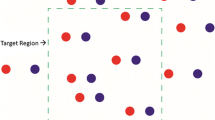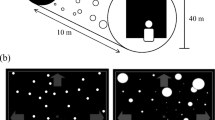Abstract
Human observers dichoptically viewed displays consisting of isotropic random dots, with the dots in each eye's view all moving in a given direction or appearing stationary. When the interocular difference in direction of motion was less than 30 deg, a stable, fused percept resulted. Once this interocular difference was exceeded, binocular rivalry ensued. Rivalry was also obtained when dots seen by the two eyes moved in identical directions but at different velocities. Under this condition, the proportion of time that rivalry was experienced increased with the interocular difference in velocity. Moving dots predominated over stationary ones, and when both sets of dots moved there was no clear advantage of one speed of motion over the other. Contrary to some earlier reports, these results show that motion is not immune to binocular rivalry. Evidently the process responsible for establishing binocular correspondence between images received by the two eyes is sensitive to disparities in direction and velocity of motion.
Similar content being viewed by others
References
Blakemore C (1970) A new kind of stereopsis. Vision Res 10:1181–1199
Blakemore C, Campbell FW (1969) On the existence of neurones in the human visual system selectively sensitive to the orientation and size of retinal images. J Physiol 203:237–260
Braddick O (1979) Binocular single vision and perceptual processing. Proc R Soc Lond B 204:503–512
Breese BB (1899) On inhibition. Psychol Monogr 3:1–65
Fox R, Todd S, Bettinger LA (1975) Optokinetic nystagmus as an objective indicator of binocular rivalry. Vision Res 15:849–853
Hollins M (1980) The effect of contrast on the completeness of binocular rivalry. Percept Psychophys 27:550–556
Hollins M, Leung EHL (1978) The influence of color on binocular rivalry. In: Armington JC, Krauskopf J, Wooten BR (eds) Visual psychophysics and physiology. Academic Press, New York, pp 181–190
Julesz B, Miller JE (1975) Independent spatial frequency-tuned channels in binocular fusion and rivalry. Perception 4:125–143
Kertesz AE, Jones RW (1970) Human cyclofusional response. Vision Res 10:891–896
Levelt WJM (1965) On binocular rivalry. Institute for Perception RVO-TNO, Soesterberg, The Netherlands
Levinson E, Sekuler R (1980) A two-dimensional analysis of direction specific adaptation. Vision Res 20:103–107
Marr D, Poggio T (1979) A computational theory of human stereo vision. Proc R Soc Lond B 204:301–328
Marshak W, Sekuler RW (1979) Mutual repulsion between moving visual targets. Science 205:1399–1401
Maunsell JHR, Van Essen DC (1983) Functional properties of neurons in middle temporal visual area of the Macaque Monkey. II. Binocular interactions and sensitivity to binocular disparity. J Neurophysiol 49:1148–1167
Pettigrew JD, Nikara T, Bishop PO (1968) Binocular interaction on single units in cat striate cortex: simultaneous stimulation by single moving slit with receptive fields in correspondence. Exp Brain Res 6:391–416
Regan D, Beverley Kl, Cynader M (1979) Stereoscopic subsystems for position in depth and for motion in depth. Proc R Soc Lond B 204:485–501
Sabrin H, Kertesz A (1983) The effect of imposed fixational eye movements on binocular rivalry. Percept Psychophys 34:155–157
Tynan P, Sekuler RW (1977) Rapid measurement of contrast sensitivity functions. Am J Optom Physiol Optics 54:573–575
Wade NJ (1974) Monocular and binocular rivalry between contours. Perception 4:85–95
Wade NJ, De Weert CMM, Swanston MT (1984) Binocular rivalry with moving patterns. Percept Psychophys 35:111–122
Zeki SM (1979) Functional specialization and binocular interaction in the visual areas of rhesus monkey prestriate cortex. Proc R Soc Lond B 204:379–397
Author information
Authors and Affiliations
Rights and permissions
About this article
Cite this article
Blake, R., Zimba, L. & Williams, D. Visual motion, binocular correspondence and binocular rivalry. Biol. Cybern. 52, 391–397 (1985). https://doi.org/10.1007/BF00449596
Received:
Issue Date:
DOI: https://doi.org/10.1007/BF00449596




